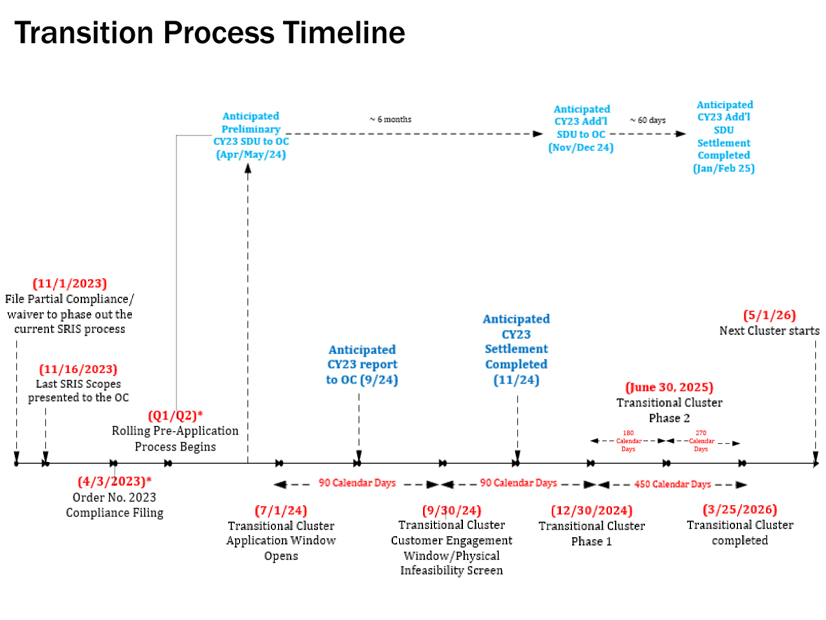RENSSELAER, N.Y. — Stakeholders at NYISO’s Nov. 4 Interconnection Issues Task Force meeting expressed reservations about the grid operator’s proposed interconnection queue rules, citing concerns over the length of time to make project decisions and deposit requirements.
Following the ISO’s presentation of proposed study deposits and withdrawal penalties, Troutman Pepper partner Stu Caplan, who represents the New York Transmission Owners, highlighted the uncertainty surrounding the transition to NYISO’s proposed phased cluster approach. “There’s a big variable that we don’t know the answer to yet, the feasibility of the timeframes to complete the [interconnection] studies,” he said.
NYISO’s proposal to comply with FERC Order 2023 would give developers a seven-day window after each phase to decide whether to proceed or withdraw from the queue based on results from the preceding study phase.
The ISO proposes to charge interconnection applicants a non-refundable $10,000 fee, as well as a one-time study deposit ranging from $100,000 to $250,000 based on the size of the proposed project. For capacity resource interconnection service-only projects, the deposit would be $50,000. Additionally, in lieu of regulatory milestones, developers would be required to make commercial readiness deposits to progress through the queue phases, with amounts escalating at each stage: depositing $4,000/MW to enter Phase 1, depositing the greater of either the Phase 1 deposit or 20% of the cost estimate determined in Phase 1 to move into Phase 2, and 100% of a project’s cost estimate to move out of Phase 2.
NYISO also outlined penalties for developers who withdraw from the queue: up to 100% of their study deposit, plus 20% of the Phase 2 deposit if they withdraw during the decision period at the end of Phase 2.
Reid Wagner, a clean energy markets analyst with the Alliance for Clean Energy New York, said the ISO’s proposed timelines are too short. “Seven days could be hard for some companies, particularly international ones, to secure the funding in that short period of time,” he said.
ISO attorney Sara Keegan responded that developers would “have ample time to get their ducks in a row” and make decisions about whether to move a project forward through the queue. Project cost estimates would be available “well before the seven-day trigger,” she said.
Wagner then asked if the ISO would consider conducting a “harm test” at the end of each phase, as currently done by MISO, to “test how much harm a withdrawn project has caused to the other queued projects.”
Keegan responded that NYISO is not considering a harm test akin to MISO’s. “It is perhaps overly complicated, and we feel like that would make it incredibly difficult to administer, since we would end up needing a whole department to administer withdrawal penalties,” she said.
Stakeholders also expressed frustration with NYISO’s initial plan to accept only cash for study deposits, rather than allowing the use of credit.
Saad Syed, grid and interconnection manager with OW Ocean Winds, argued for flexibility, saying, “putting up much money in cash in such short intervals seems very difficult, on top of the withdrawal penalties that may occur. So, I strongly recommend using at least an ability to use letters of credit for [these deposits], since otherwise it might become untenable.”
Echoing this sentiment, Abhishek Josh Ghosh, associate director with Cypress Creek Renewables, recommended that NYISO draw insights from PJM, which allows letters of credit in its processes. “It would be nice to have some flexibility in posting these deposits,” he said.
Thinh Nguyen, NYISO senior manager of interconnection projects, acknowledged these concerns and committed to revisiting the payment options. “We are still considering whether a letter of credit is another option. But as you are aware, when we receive letters of credit, that means we have to do some kind of credit check on that entity,” he said. “That’s why we want to make sure that whatever the process we want to use is able to support and meet the very tight defined timelines.”
FERC last month extended the Order 2023 compliance deadline from Dec. 5 to April 3, 2024. (See FERC Extends Interconnection Queue Compliance Deadline.)
Despite the extension, Keegan informed the IITF that NYISO still intends to submit a partial compliance filing by Dec. 1. (See NYISO Plans Early November Filing for Partial Order 2023 Compliance.) The IITF will reconvene Nov. 14.




